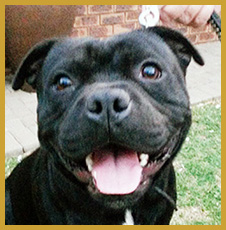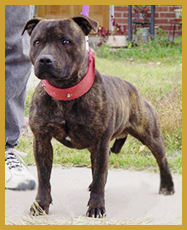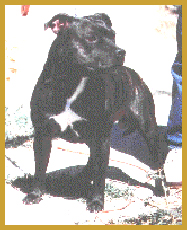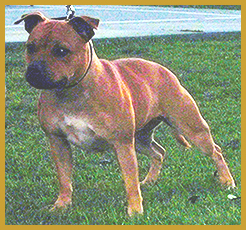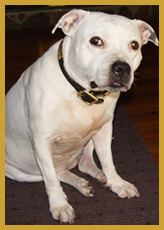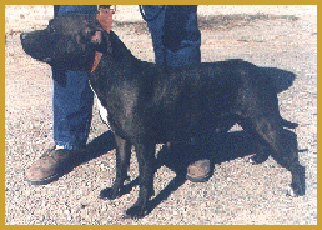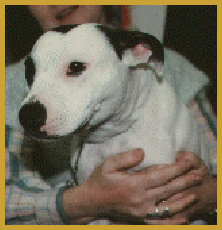Breed Specific Legislation (BSL)
A BULL-BREEDS MANIFESTO
In the United States, a vast shadowy netherworld of dog owners exists as a visible but seldom recognized subculture, for its disorderly yet inconspicuous multitudes operate in a manner quite unlike that of show-dog fanciers and do not even vaguely resemble responsible pet owners. Although its numbers are legion, fanciers and pet owners alike seem strangely oblivious to its existence. For decades its denizens have been searching for the ideal junkyard dog, a large ferocious beast designed to instill terror in one and all. As faddish as the show-dog set, the minions of this netherworld have stigmatized one legitimate breed after another while seeking fulfillment of its fantasies.
Before and just after WWII, this far-flung proletariat discovered the German Shepherd, staying in that breed for many years and ruining its illustrious reputation before moving on to the Doberman which quickly became the bully-dog of choice. After ruining the Doberman's good name, it got hold of Rough Collies and then Saint Bernards, doing almost irreparable harm to both breeds' repute.
After a brief period of floundering, dwellers of the abyss concocted the notion of acquiring Pitbulls, a breed that had inhabited America for more than a century, becoming a widely admired American icon, including famous dogs such as Sally Ann Jarrett of Civil War fame, the Canton Bulldogs professional football mascot, and Pete of "Our Gang" movie fame. Having previously dealt with less dynamic and less complex canines, they undertook the task woefully unprepared to cope with the Pitbull which they began to acquire in numbers during the middle 1970's. Ignorant of "The Law of Unintended Consequences," they took on a great deal more than they had anticipated.
For one thing, the Pitbull turned out much easier to degrade than most other breeds. Possibly the greatest canine athlete, it possesses a temperament unlike anything they had ever encountered.. Incredibly tough and resilient, the dog can withstand much mistreatment with relatively little ill effect. However, contrary to media-induced legend, in temperament it is legendary for super-sensitivity to its owners' presence - or lack thereof - difficult as that may be for the general public to understand, having been force-fed media hyperbole about the "vicious, ferocious, voracious" Pitbull. True, it was originally a fighting dog bred specifically to fight only other Pitbulls, not as a berserker but coolly and carefully as does a professional human prizefighter. It was equally bred to tolerate human intervention by its handlers during fights, that is, it could never be allowed to bite humans under any circumstances, not even under duress. This remarkable duality of temperament is not unique among canines but may be most pronounced and unequivocal in the fighting dog. Their ignorant new patrons regarded love and attention as simply another matter to put on short ration and systematically ignored them, isolating them from human companionship and forcing them to exist without human affection. Most Pitbulls treated in this manner developed deviant and abnormal temperaments, becoming vicious parodies of the real thing. When turned loose to run in the streets, disaster followed as an inevitable result.
Completing the process of ruining not just individual dogs but the reputation of an entire breed, the subculture follows an unchanging modus operandi: at first its "top echelon" buys pet-quality pups without papers from unsuspecting legitimate novice breeders or obtains them from animal rescue stations or steals them from homes as it has no regard for pedigree or registration. Rather than practice reasonable animal husbandry, the new owners cage or chain the unfortunate charges in the back yard, do not bother to feed them properly or administer necessary veterinary care. They encourage their dogs to behave savagely and - by preference - to attack on command. Naturally the "training" borders upon the barbaric and serves only to destabilize already unpredictable specimens. Further, with no regard for consequences, they breed sister to brother, father to daughter, mother to son. Early litters sell for seventy-five dollars per pup while the next generation sells for fifty and following generations for thirty-five. They breed bitches on the first heat and every heat thereafter, shotgunning them when whelping problem occur or infertility sets in. Three or four generations of such indiscriminate breeding guarantees that the offspring turn out to be substandard, particularly in regard to temperament.
When negligent owners allow any ill-bred and abused dog, irrespective of breed, to roam at large or to escape confinement, an opportunity for canine incidents arises, but when these bad owners deliberately turned loose their exploited and neglected Pitbulls to run free, unprovoked attacks on unsuspecting humans did occur with stunning violence. Such attacks during "slow news periods" caused the print and electronic media to indulge in yet another feeding frenzy. Ill-trained journalists sallied forth to dredge up "experts," only to ignore or misquote them while pumping out sensationalized stories that focused on the "bad dog" but seldom or never on the bad owner. As might be expected, a sizable portion of the non-doggy public took such screed at face value, and before long the reputation of yet another breed lay in shreds. Meanwhile, tens of thousands of well-bred Pitbulls, owned by responsible citizens and kept under loving control at all times, remained at home as model canine citizens - but that situation never seemed to qualify as "news" in the media's eyes.
Following the unprecedented Pitbull population explosion in the late 1980's came wave upon wave of horror stories about Pitbull attacks against humans, some true, some fabricated, filling newspapers and flooding newscasts. The public reacted sharply with understandable alarm, and the "Pitbull menace" instantly became part of the public psyche. Drastic citizen reaction and resulting police pressure soon became so intense that netherworlders began to realize that they were about to pay for their practices. Rather than reform, however, they simply dumped huge numbers of their pathetic charges at local pounds and shelters to be euthanized. First gradually and then at an accelerated rate, the Pitbull population dwindled until finally the relatively few remaining Pitbull owners came to represent extreme polar opposites: 1) the vast majority of original lifelong Pitbull fanciers and 2) an infinitesimal minority composed of unrepentant, mostly drug dealers.
By the time the subculture came to realize that in the Pitbull it had got a potato much to hot to handle, it left a Dark-Ages legacy in canine history. Today, the great Pitbull menace is over, gone, kaput - and has been for a decade although its media-imprinted image lingers in public memory.
That shadowy subculture, however, never rests and is well advanced in the process of ruining yet another breed.
It has taken over Rottweilers.
Steve Stone
ADOLPH HITLER IS ALIVE AND WELL
Adolph Hitler is alive and well, at least in spirit if not the flesh, thriving in a Germany recently reunified and re-energized by the resurgence of its medieval xenophobia. Casting aside its flimsy facade of quasi-civilization and pseudo-democracy, the Fourth Reich has emerged.
Rather than Jews, Gypsies, Slavs, Freemasons, Catholics, Socialists, and dissenters, Germany has focused its new-fired genocidal energy not on Man but on Man's Best Friend by legally banning four specific non-German breeds: the American Staffordshire Terrier, American Pitbull Terrier, (English) Bull Terrier, and (English) Staffordshire Bull Terrier. No German breed, not even the Boxer or Doberman, appears on the list of proscribed "dangerous" breeds that will soon include all bull breeds as well as non-German large breeds.
Germany's "rationale" stems from the horrible dog-attack death of a six year old boy named Volkan on June 16, 2000, when an American Pitbull and an American Staffordshire Terrier, owned by a notorious drug dealer named Ibrahim, attacked and killed the boy on the Wildhelmsburg school playground in Hamburg. Ibrahim had delighted in training his dogs to be people-aggressive and was well known to the city police who did little or nothing to curb his activities. Quite correctly, authorities destroyed both dogs after the fatal attack on Volkan but later found that Ibrahim had been dosing his dogs with illegal drugs. Subsequently, in sad aftermath, a German court sentenced Ibrahim to an outrageously lenient 42-month prison term for what amounts to capital murder.
Without benefit of research or consideration, the 16 federal states in Germany rushed pell-mell to announce that the problem lies not with criminal owners, to whom police had been turning a blind eye, but with the dogs themselves and particularly with dogs having a "fighting heritage," that is, four bull-and-terrier breeds. The German states lost no time banning all dogs of these breeds and ordered the confiscation, internment, and execution of countless family pets irrespective of individual innocence or guilt in a manner that would have made the Gestapo proud - with the hearty approval of a servile German public. In doing so Germany employed the traditional mechanism of fascism: violation of due process in company with blatant disregard for individual owners' constitutional rights.
To date German courts have done little or nothing to confirm and protect these rights. Meanwhile, the German government is doing its best to make the entire European Union adopt its dog legislation.
At first glance, it may seem proper for Germany to employ Breed Specific Legislation (BSL) to eliminate "dangerous" breeds because the public does need vigorous protection against dog attacks. But BSL, by utilizing all the wrong methods, not only fails to protect citizens but law-abiding dog owners as well. It falls well short of its stated goal by not recognizing that specific dogs rather than specific breeds constitute a problem, for no breed in and of itself is dangerous. Any individual dog of any breed may become dangerous, almost invariably due to bad owners.
In fact, "the dog problem" is not a dog problem at all but a "people problem" - more specifically, an owner problem.
Rather than ineffective BSL, the public needs robust legislation integrated with effective enforcement to punish all careless, indifferent, or criminal owners who fail to take full precautions to protect the populace from their dangerous dogs, without reference to breed. Classifying all members of a specific breed as being dangerous contravenes science and reason, flying in the face of experience and common sense. In this case, as always, tyranny's handmaiden is the closed mind that fixates on one irrational concept to the exclusion of all else and the refusal to accept rational argumentation or contrary evidence, scientific or otherwise.
And so it has come to pass in Germany. Incredibly, the German mania is beginning to take hold in France and is spreading like rat-borne plague to those other European countries that Germany can manage to intimidate. Moreover, the Fourth Reich's very own "final solution" is beginning to attract benign attention outside German borders in places as remote as Australia and America. Unless challenged, met, and defeated by bullbreed owners - not just those of the banned-in-Germany quartet but the Bulldog, the Mastiff, the Bull Mastiff, the Great Dane, the Boston Terrier, the French Bulldog, and many others - BSL imperils owners and dogs in every corner of the planet.
Some have compared Germany's current methods to those used during the Holocaust, only to be warned against offending German sensibilities and thus making the Germans even more intransigent. Developments, however, have rendered such considerations obsolete, for Germany has put itself utterly beyond the pale. Oddly and lamentably, the government of France seems only too eager to serve as the Fatherland's lackey.
However, many bull-breed owners in the English-speaking countries - America, Canada, Australia, New Zealand, South Africa - are beginning to sense the ominous portents emanating from the very shadows of Buchenwald. They number in the tens and even hundreds of thousands - voters all - and are beginning to unite into cadres representing all the many bull breeds. They are preparing to resist and defeat every irrational BSL initiative wherever it turns up through sheer strength of numbers. At present their movement is still in baby-shoes because not every owner yet realizes fully that he, himself, occupies a prominent spot on the next hit list, but the message is at least beginning to filter through to even the densest.
Benjamin Franklin, holding no illusions about the consequences of signing the Declaration of Independence, was stating a simple reality when he declared, "Gentlemen, we must now all hang together or we will all surely hang separately." Nor should bullbreed owners harbor any illusion about the virulence of the Yellow/black/red Menace. Surely, complacent activists who cling to petty differences and fail to unite against the oncoming BSL onslaught can look forward to experiencing the rudest of all awakenings on that not-so-distant day when they are forced to watch as their family favorites inhale a last living breath of Cyklon B, a fate these most loyal of all companions surely never deserved.
Steve Stone
JUST DO THE MATH!
When an ill-advised community council or misguided nation attempts to enact Breed Specific Legislation (BSL) in a well-meant but vain effort to safeguard the public against bites and attacks from vicious dogs, its benighted politicos invariably propose that these three breeds be proscribed: 1) the Pitbull 2) the American Staffordshire Terrier, and 3) the (English) Staffordshire Bull Terrier. Including #3, known also as the Stafford, on any list of alleged dangerous dogs not only surpasses the ridiculous but teeters perilously on the demented.
When actually put to the test, BSL proves to be nothing more than a placebo that treats only one symptom instead of curing the disease. No matter how efficiently enforced, BSL does not - cannot - serve the public effectively because bites and attacks come from a wide variety of breeds and are nearly always the result of problem owners rather than problem canines.
The folly of banning any specific breed lies in the established scientific fact that, genetically speaking, desirable and undesirable characteristics in temperament exist in all breeds rather than being limited to any particular breed or group. To label any breed as being composed of only "desirable" or "undesirable" specimens is to speak scientific nonsense.
Legislators should indeed enact effective laws against all owners of all vicious dogs regardless of breed, size, or type. Such laws ought to hold owners strictly responsible, financially and otherwise, for damage and injuries that their canines cause. Further, they should give courts the authority to act not only against negligent owners but on behalf of victims of unprovoked dog attacks.
In practice, the rule of thumb holds that acceptable or unacceptable behavior springs from dogs being owned by good (competent, loving) owners or bad (inept, uncaring) owners. The birthplace of the Staffordshire Bull Terrier, however, constitutes the exception that proves this rule. In England Staffords have become a remarkably popular family pet, yet while a certain fraction of owners certainly are "bad owners," that tight little island has never experienced a "Stafford problem."
Specifically, the Stafford originated in England's industrial Midlands - Birmingham and environs - where it first attained Kennel Club recognition in 1935 with 174 registered dogs. Following World War II, the Stafford's annual registrations rose to nearly 1,000 and by 1960 attained the 2,000 threshold, only a minute fraction of which - probably fewer than one hundred, combined - were exported to Australia, Canada, New Zealand, South Africa, and the United States.
The first paragraph of the 1948 Breed Standard states:
-
"From the past history of the Staffordshire Bull Terrier, the modern dog draws its character of indomitable courage, high intelligence, and tenacity. This, coupled with its affection for its friends, and children in particular, its off-duty quietness and trustworthy stability, makes it a foremost all-purpose dog."
During ensuing decades the Stafford went from strength to strength on the bedrock basis of its utterly reliable temperament among the English, Irish, Welsh, and Scots and over time became the UK's most popular smooth-haired terrier. In not a few families Stafford ownership passed from grandfather to son to grandson. Extensive experience ingrained owners with an intimate knowledge of the dog's true temperament, one salient facet of which, long since proven to a certainty but either ignored by or unknown to BSL advocates, being: not even prolonged, intensive, and specialized training can induce a Stafford to attack a human being. Conversely, over the last six and a half decades Staffords have repeatedly demonstrated their willingness to sacrifice their own lives in defense of their human families.
For the last decade, Kennel Club registrations have approximated 8,000 per year. Assuming a minimum average ten-year lifespan, at least 80,000 purebred registered Staffords and 60 million inhabitants currently inhabit the UK, an area of 93,000 square miles, slightly smaller than Oregon or Wyoming. Put another way, Britain contains nearly one Stafford per square mile of land surface and houses one Stafford per 750 persons, far more than any other country. Virtually all Staffords live inside the home with their human families because as a breed they tend to suffer when isolated from human companionship.
Despite a high proportion of Staffords per capita in such a restricted geographical area, no authenticated report of a purebred registered Staffordshire Bull Terrier attacking a human in the British Isles has ever been recorded. Doubters need only do the math: through more than six decades, more than quarter of a million purebred registered Staffords have been living cheek-by-jowl with more than 60 million humans, yet never once has a Stafford attacked a person. This incontrovertible fact must lead anyone with the faintest capacity for critical thinking to the inevitable conclusion that not even by the most maniacal criteria can the Staffordshire Bull Terrier be considered dangerous. If they were actually dangerous, as BSL initiatives charge, Britain's streets would run ankle-deep in blood while lacerated bodies filled its hospitals and mangled corpses glutted its cemeteries.
Actually, it's not math at all but simple arithmetic, easily accessible to every schoolchild.
Steve Stone
HUMAN NATURE AND THE LEGISLATURE
Like America's anti-alcohol Prohibition and South Africa's Apartheid, certain third-rate ideas seem to float up from the quagmire and waft around the world, waiting to be seized upon by third-rate intellects that possess little inclination to think a subject through. If acted upon, these ideas can leave ugly and sometimes tragic consequences in their wake.
One such current third-rate idea in government centers around Breed Specific Legislation (BSL) which some politicians assume will help protect the public from bites and attacks by vicious dogs. The notion seems to be that if two or three specific breeds, designated as "dangerous," are banned, the number of bites and attacks will be drastically reduced.
Even the best Breed Specific Legislation efforts suffer from flaws and shortcomings, the greatest of which lies in the legislative assumption that bites and attacks are part of a dog problem whereas, on the contrary, they constitute an owner problem. No dog, irrespective of breed - when properly bred, raised, cared for, and controlled - ever causes a real problem because conscientious owners rigorously eliminate potential problem dogs before trouble occurs. No one yearns more earnestly than purebred dog fanciers and responsible pet owners for stringent and genuinely effective dog legislation, for it is they who stand to lose the most as a result of half-baked BSL laws that have always proven to be an illusory panacea.
The second great weakness in Breed Specific Legislation resides in the fact that attacks against humans are perpetrated by a wide variety of breeds, large and small, as well as crossbreds and mongrels. If a legislative body were to initiate a list of banned breeds with the Pitbull, the AmStaff, and the Stafford, it would then be obliged to pass - in rapid succession - amendments against the German Shepherd, the Doberman, the Boxer, and many other breeds, including some that are not of German origin.
The third great deficiency of Breed Specific Legislation derives from the cold fact that it lacks even a semblance of a scientific, statistical, or historical basis, being little more than a pastiche of media headlines, public hysteria, and old wives' tales. Particularly in this respect it resembles Prohibition and Apartheid.
Leading the list of BSL-banned breeds, in such disparate places as Hamburg, Germany, and Cincinnati, Ohio, comes the Pitbull, followed by the American Staffordshire Terrier and the (English) Staffordshire Bull Terrier, all of which legislators designate as "fighting dogs." The premise seems to be that if a dog has Bulldog heritage and was originally bred to fight in the pit, it is by definition a vicious dog, that is, a dog that will bite without provocation. This misconception arises from a "perfectly natural" but wholly fallacious assumption that a bred-in-the-bone fighting dog embodied by nature and training a kill-crazy canine berserker, but in fact pit dogs resembled human prizefighters in that they fought calmly and coolly, purely for their own enjoyment (strange as that may seem), and were equally bred not to bite their human companions and handlers, even under extreme duress.
The Staffordshire Bull Terrier gives living lie to Breed Specific Legislation. In 1935 the (English) Kennel Club recognized the Breed's 174 specimens, almost all of which came from the pit. Their direct descendants, the approximately 80,000 Staffords now residing among the UK's 60,000 000 inhabitants, have been living solely as show dogs and family companions for more than 40 canine generations. Calling modern Staffords "fighting dogs" is a greater injustice than calling today's Norwegians, Danes, and Swedes "bloodthirsty Vikings."
Since 1935 something like a quarter of a million Staffords have lived cheek-by-jowl with about a hundred million Britons without so much as a single authenticated report of a purebred Stafford attacking a person. Moreover, Stafford folk have proven beyond doubt that a purebred Stafford cannot be successfully trained to attack people, even on command.
If BSL can be so terribly wrong about the true nature of the Staffordshire Bull Terriers, one can safely bet that it is equally mistaken about the true nature of the American Staffordshire Terrier and the Pitbull. Besides, as stated above, dogs do not cause the problem.
Owners do.
Steve Stone
FOLLOWING FINLAND'S LEAD
While local governments in much of the western world thresh futilely about searching for convoluted solutions to the growing problem of dog attacks, Finland has been quietly leading the way in canine legislation as it has been leading in so many other fields, such as cell phone manufacture and newsprint production. What it has done is neither sophisticated nor magical, being the product of simple practicality and everyday common sense. Briefly put, the Finnish solution consists of two elements: 1) Control the dog population, and 2) make all owners completely responsible for all consequences of their dogs' behavior.
A country, roughly the size of Minnesota (but having 160,000 lakes), with a current human population of five million, Finland gained complete independence in 1917 and struggled to establish its governmental and social institutions before the onset of World War II. Attacked without warning by the Soviet Union in November, 1939, her heroic resistance against the Red Army during the Winter War gained her the admiration of the entire free world before she attained an armistice with the USSR in March, 1940. Once again sucked into the vortex of war in June, 1941, Finland fought for her independence for three agonizing years before again achieving a separate armistice in October, 1944.
During the war years, Finns hovered on the very brink between existence and non-existence, resources strained to the breaking point. (Each Finnish citizen's monthly ration of butter consisted of exactly one pat, and Finnish women were called upon to donate their gold wedding rings to the National Treasury.) Under these most rigorous circumstances, all but the most valuable breeding dogs were humanely put down, for the others could not be fed.
Consequently, upon the termination of hostilities the entire nation possessed a mere handful of canines, so the Finnish government passed legislation to prevent a canine population explosion, taking into account that almost all urban and suburban Finns lived in multi-unit housing co-operatives somewhat comparable to condominiums. It mandated strict enforcement of a universal leash law to apply to any dog found off-leash, on the street or in the open. Further, owners were to be held strictly liable, financially and legally, for any and all damage or injury caused by their dogs, even when on-leash.
Strictly enforced by a vigilant constabulary, these laws insured that no crossbreds or mongrels were produced by uncaring or careless owners. They also insured that the value and price of purebred dogs could be stabilized and maintained. As a result, the nation did not need to employ dogcatchers or build dog pounds.
Dog fanciers, even those who originally felt themselves aggrieved by the restrictive nature of the legislation, soon realized its remarkable advantages and quickly became its advocates. Before long, they themselves became in effect an arm of the law, notifying the authorities of violations and violators because doing so was in their own best interests.
One can only consider the Finns a nation of animal lovers, for they have a native Finnish breed of milk cow, the native Finnhorse (world's fastest cold-blooded trotter), the native Finnsheep, and several breeds of native Finnish dogs including the Finnish Hound and two "export models," the Finnish Spitz and the Karelian Bear Dog. As if that weren't enough, Finns are continually importing non-native dog breeds from around the world.
One such breed, the Staffordshire Bull Terrier, first arrived in Finland on April 4, 1964, and within two years its ranks swelled to more than thirty. Within ten years of its arrival, the Stafford had become the most popular terrier breed in the country (being of moderate size, smooth-coated, and having a Finnish-type tenacious temperament). Not long ago, total Finnish Kennel Club registrations of Staffords from 1964 to the present topped the 10,000 mark.
During those 35-plus years, not one authenticated case of a Stafford bite, much less an attack, has ever been officially documented despite the fact that every Stafford has lived with its family inside the condominium, Finnish winters being such that neither man nor beast can survive in the open. Yes, the very same Staffordshire Bull Terrier that strikes terror into the hearts of "good" Germans, the very same dog that Deutsch legislators have stigmatized as " an aggressive fighting machine" and "a threat to the public." No, not a different strain, not a variant bloodline, but the same strain and bloodline that derive directly from Staffords in their mother country, England, where this highly popular breed boasts an unparalleled record of accommodation and friendship with homo sapiens.
Given the evidence, one might reasonably conclude that German legislators do not fall into that classification. Well, maybe the "homo" but certainly not the "sapiens."
Steve Stone
